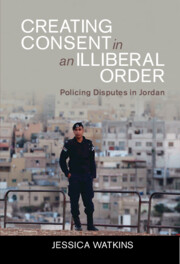Book contents
- Creating Consent in an Illiberal Order
- Cambridge Middle East Studies
- Creating Consent in an Illiberal Order
- Copyright page
- Contents
- Figures
- Maps
- Tables
- Preface
- Acknowledgements
- Note on Transliterations
- Abbreviations
- 1 Introduction
- 2 Strategic Alliances and Amalgamated Social Orders
- 3 State Policing, from the Ottoman Gendarmerie to the Public Security Directorate
- 4 Criminalising Disputes and Disputing Criminality
- 5 Policing Blood Crimes in the (Neo)Tribal Tradition
- 6 Policing Domestic Abuse
- 7 Community Policing After the Uprisings
- 8 From Neoliberal Securitised Policing Back to the Disputing Process
- Bibliography
- Index
- Books in the Series
- References
Bibliography
Published online by Cambridge University Press: 02 June 2022
- Creating Consent in an Illiberal Order
- Cambridge Middle East Studies
- Creating Consent in an Illiberal Order
- Copyright page
- Contents
- Figures
- Maps
- Tables
- Preface
- Acknowledgements
- Note on Transliterations
- Abbreviations
- 1 Introduction
- 2 Strategic Alliances and Amalgamated Social Orders
- 3 State Policing, from the Ottoman Gendarmerie to the Public Security Directorate
- 4 Criminalising Disputes and Disputing Criminality
- 5 Policing Blood Crimes in the (Neo)Tribal Tradition
- 6 Policing Domestic Abuse
- 7 Community Policing After the Uprisings
- 8 From Neoliberal Securitised Policing Back to the Disputing Process
- Bibliography
- Index
- Books in the Series
- References
Summary

- Type
- Chapter
- Information
- Creating Consent in an Illiberal OrderPolicing Disputes in Jordan, pp. 213 - 225Publisher: Cambridge University PressPrint publication year: 2022

